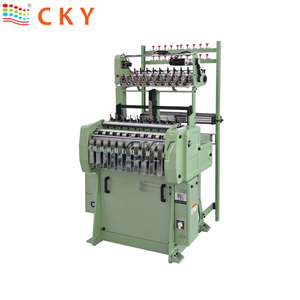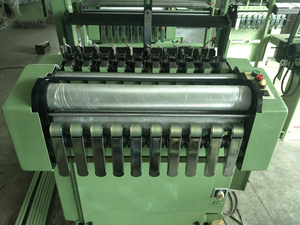(204 products available)























































































































































































A heavy belt needle loom machine is a textile-making instrument used to create heavy, tough cotton belts for varied uses, including industrial, agricultural, military, and construction sectors. Because of its broad applicability, numerous needle loom types have been created to weave heavy goods.
Wide-width needle looms:
Wide-width needle looms are the traditional needle loom types. They use a series of needles, each of which has a thread-carrying hook, to weave thick cotton fabric. A distinctive feature of these looms is that they interlace the warp strands one by one, which accounts for the delicacy of the final goods. A solid, weighty belt is produced as a consequence of this accurate control over the interlacing process. The wide-width heavy cotton needle loom can manufacture broad belts to fulfil particular requirements because of its design. Heavy-duty wide-width needle looms are available in a variety of varieties, each suited for a certain belt width.
Dobby heavy belt needle looms:
Dobby heavy belt needle looms are complex machines that produce belts with intricate patterned interlacements. These looms use a device known as a dobby to control the release of the warp threads, allowing for more varied and elaborate designs than those achievable with basic looms. Dobby heavy belt needle looms have excellent design versatility and can create personalized belts that satisfy particular consumer preferences.
Electronic heavy belt needle looms:
Electronic heavy belt needle looms represent a modern and efficient option in the loom-weaving industry. The loom's needle release and warp-thread interweaving processes are controlled electronically with the help of a computer system. This electronic control makes it easier to set up weaving patterns, and the precision at which it weaves warp and weft threads guarantees that the finished items have a high level of accuracy and quality. Moreover, Electronic heavy belt needle looms often have quick production speeds and adaptive weaving widths to accommodate production demands.
The performance of a machine is greatly influenced by its specifications, all the more so when this machine is a heavy belt needle loom. On that note, here are some typical specifications of a heavy needle loom belt weaving machine:
Material Compatibility:
An effective heavy needle loom for belts is compatible with various heavy materials. Weavers commonly use heavy cotton, polyester, nylon, and other materials that give the final product durability.
Needle Gauge:
The needle gauge indicates the size and thickness of the needles used in the loom. It determines the weight and density of the belts that can be woven. Heavy needle looms typically use larger gauge needles.
Weaving Width:
Weaving width is the maximum width of the belts that can be woven. Heavy needle looms for belts come in different weaving widths to accommodate various belt width requirements.
Weaving Speed:
Weaving speed refers to the speed at which the loom weaves the belt. It is usually measured in meters per minute. The weaving speed may vary depending on the needle gauge.
Weaving Mechanism:
There are different types of heavy needle looms for belts, each with a specific weaving mechanism. Some common weaving mechanisms include warping and weft insertion.
Machine Dimensions:
These dimensions include height, width, length as well as weight. A typical dimension of a heavy needle loom machine is 150×80×160cm, and the weight is about 200kg.
Even a small heavy belt loom machine benefits from routine maintenance. The benefits of maintenance are endless. Not only does it enhance the performance of the needle loom machine, but it also increases its lifespan. Here are some upkeep tips to keep the heavy needle belt loom in great shape:
Lubrication:
Regular oiling of moving parts of the weaving machine is crucial for its smooth operation and prevention of unnecessary wear and tear. Parts such as bearings, shafts, and the needle mechanism should never miss lubrication.
Regular cleaning:
This is more like a no-brainer. But as obvious as it may seem, it still needs to be said and done. Frequent removal of dust and lint keeps the heavy needle looms in pristine condition. It prevents damage to the machine parts. Rags and brushes can be used to clean the looms. Compressed air can also help reach the difficult parts.
The wide application of heavy needle looms has increased the demand for this machine in manufacturing industries. The following are some of the business applications of the heavy needle loom:
There are numerous types and models of heavy belt needle looms for sale. Buyers can use the following tips to help them select the right needle loom:
Q1: What is the difference between a needle loom and a flat loom?
A1: Needle looms use a series of needles to insert wefts into warp yarns, while flat looms use a shuttle mechanism to insert wefts. Needle looms are more suitable for heavy and dense fabrics, while flat looms can be used for various fabric thicknesses.
Q2: Can needle looms weave elastic materials?
A2: While most needle looms are designed to weave rigid materials, certain models can accommodate elastic or stretchy materials. Such machines would typically possess modified needles and feed mechanisms to handle elastic substrates effectively.
Q3: What are the benefits of using an automatic needle loom?
A3: Heavy automatic needle looms offer higher production rates, reduced labor costs, faster changeover times, increased precision, and improved efficiency. They also have the potential to produce a wider variety of fabrics compared to their manual counterparts.